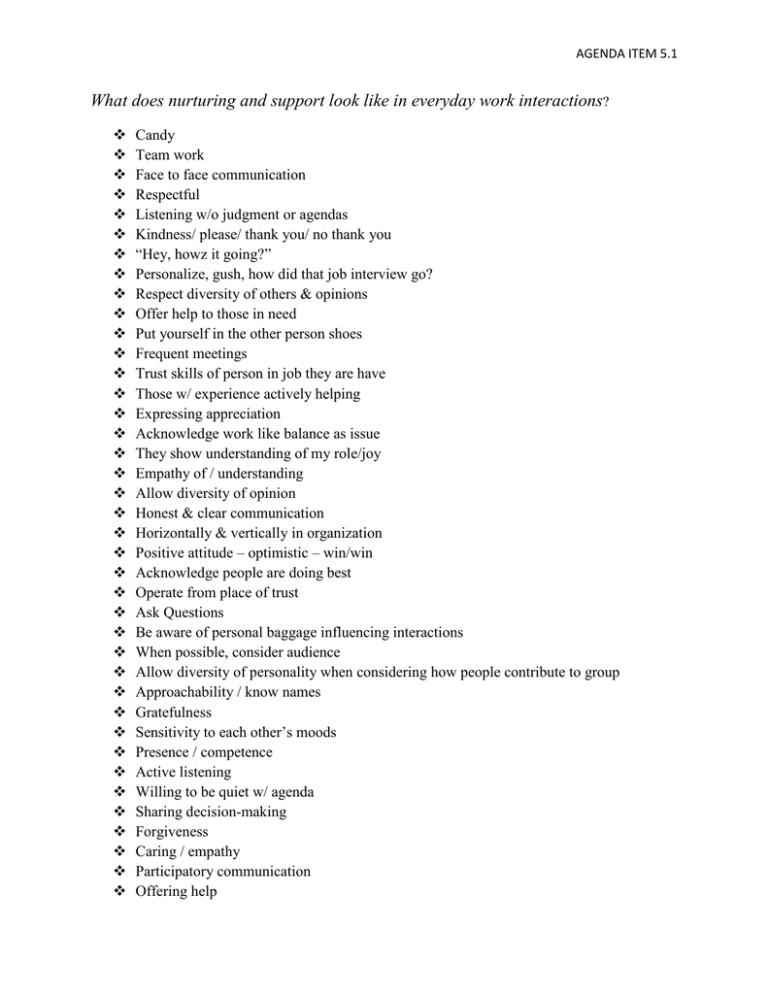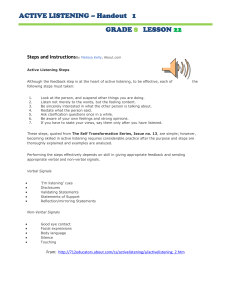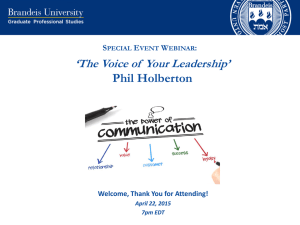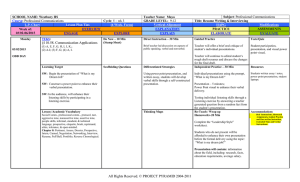What does nurturing and support look like in everyday work...
advertisement

AGENDA ITEM 5.1 What does nurturing and support look like in everyday work interactions? Candy Team work Face to face communication Respectful Listening w/o judgment or agendas Kindness/ please/ thank you/ no thank you “Hey, howz it going?” Personalize, gush, how did that job interview go? Respect diversity of others & opinions Offer help to those in need Put yourself in the other person shoes Frequent meetings Trust skills of person in job they are have Those w/ experience actively helping Expressing appreciation Acknowledge work like balance as issue They show understanding of my role/joy Empathy of / understanding Allow diversity of opinion Honest & clear communication Horizontally & vertically in organization Positive attitude – optimistic – win/win Acknowledge people are doing best Operate from place of trust Ask Questions Be aware of personal baggage influencing interactions When possible, consider audience Allow diversity of personality when considering how people contribute to group Approachability / know names Gratefulness Sensitivity to each other’s moods Presence / competence Active listening Willing to be quiet w/ agenda Sharing decision-making Forgiveness Caring / empathy Participatory communication Offering help AGENDA ITEM 5.1 Building people up Respect / respecting people’s process Not problem-solving for people Socially check-in Thankful / appreciation Polite greetings / return Using names Compassion / emotional validation – listen mindfully Awareness of / respecting self & others Difference / ideas Follow up Smiles / non verbal’s Humor Help / support – pause Teamwork – letting others help AGENDA ITEM 5.1 How can we interact in more positive and productive ways, especially when we disagree? Open-minded listener – pause Suspend – wait (a day or sleep on it) Non verbs open/positive Highlight agreement – shared goals Active listening Ok to not agree Happy or right Don’t take it personal Emotional control Issue not person Anothers perceptive Limit sarcasm Connect others Compromise Remember commonalities, common ground Careful listening / respectful & different strengths Relationship / content of communication Respect for other points of view Come back to common ground / main point o Accurate ID of disagreement Way to call disrespect out for good of group o Accountability in our civility Letting it go / balance / growth mindset Compromise Own it when wrong Default to good will Assume goodwill & not neg agenda Reflective listening Seek clarification Give yourself process time or give the other person you are disagreeing with some time Rephrase interest: what is best for students Refrain from sending emails which are diverse List all ideas; validate differences respectively; refocuson shared interest Give permission to each other to change minds Not needing to win Allowing other to have better ideas Bring a facilitator – neutral point of view Set ground rules This keeps people focused on “interest” and not personal Create a climate for innovation Have a tolerance for uncertainty Build idea “Collectively” Draw out folks who are silent AGENDA ITEM 5.1 listen – ask questions breattle Be willing to be wrong Disagree in face to face not email Find common ground – student success Assume good intentions Avoid gossip – don’t factionalize Educate yourself & be aware of o rule of gender – sensitivity of diversity (tone) Self-Awareness verbal & non verbal (tone) See positive beauty in disagreement Share % of talk-time – How long have you been talking? AGENDA ITEM 5.1 If we were to design a model of this kind of communication, what would some of the components be? Proper procedures/training Respectful professional communication o See list Avoid email to work out issues/frustrations (“don’t hit send”) Conflict resolution (constructive) Walking away/table issues for neutral space High accountability standard for those in authority Create a culture of accountability professionally challenging authority Policies Seeing construction criticism positively not an attack Avoid blame IBB / Respect Understand interest (yours) in the situation – why am I saying no? Focus on problem – ie. The common ground – about limits imposed by form of discourse Self aware – so dominant person o Doesn’t drive debate o Enable input from everyone Meet 1 on 1 Build time for meeting for closure for final check in Check in after decision Work from common ground rule Time for dialogue – “I’m just thinking” Stay focused on community & common ground Tone of voice – calm curious Issue instead of person Not interrupt Directly I / We Check intent Think before speak Golden rule – sliver rule Language – careful – agreed upon No personal attacks No speculating on motives of others Consider audience – be diplomatic (training related to how to communicate publically (email etc) Questions to ask ourselves before sending an email or comm Publically o What is my goal? AGENDA ITEM 5.1 o How will I feel when someone forwards this? o Less is more o Should I ask someone else to read o If in doubt – wait o Is subject line appropriate Email question list – wo to ask what? Deliver the mail to the right address Must trust our leaders Changing the culture takes more than making these lists – long, slow process, not product Think about the way we normally make decisions – power – make policy w/ not for Part of faculty mtg. – not just once / talk about it more Creative in our inclusion of all groups (Associate, students, K-T, Del Norte, levels of power) Remember that we ourselves are learners/training/ a;; try to feel free about open communication Surveys – create concrete measurement of change Set up contract/terms that drive Link Top role model Practice “working” dialogue” – more frequently that Develop a process for how Practice your process Be inclusive – ask other to join Respect process Even when it is hard Buy in – agreement from participants that you will follow process. Vision & goal is shared understanding by all participates. Form of disclosure o Make sure all who need to be involved can be So prepare for meetings by taking responsibility & working out dialogue outside 1 on 1 Develop strategy to engage the repetitive “no” o No as stifling






